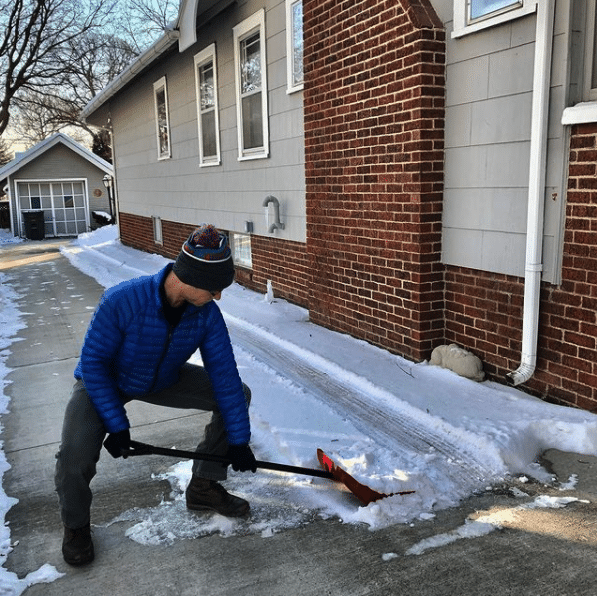
Dr. Chris LoRang squats low and pressurizes his abdomen while shoveling.
Winter is no joke
Snow adds a beautiful touch to these cold, snowy winter days. That is until you have to drive in it or remove it. Unfortunately for those of us without snow blowers, shoveling is one of those necessary evils we must do as homeowners.
Des Moines gets an average of 3 ft (36.5in) of snow per year, with the heaviest snowfall in January and February (1). These are the months when shoveling becomes most necessary.
If you thought shoveling was a benign activity, think again. “There are an estimated 11,500 snow shovel–related injuries and medical emergencies treated annually in US Emergency Departments (EDs)” (2).
What are people injuring?
“The most common diagnosis was soft tissue injury (54.7%). Injuries to the lower back accounted for 34.3% of the cases. The most common mechanism of injury/nature of medical emergency was acute musculoskeletal exertion (53.9%)” (2). Fortunately, soft tissue injuries can be effectively treated by a chiropractor or physical therapist.
Perhaps you yourself have been injured in the past. With proper knowledge and equipment, there’s no reason these numbers can’t be reduced.
Equipment
Make sure to dress the part. Properly fitted boots, gloves, hat, and a warm jacket should be worn. Foot wear is especially important to reduce the risk of slip and fall injuries.
Shovels come in all shapes, sizes, and materials. A light weight, sturdy shovel is your best bet. Heavy metal shovels should be avoided as they just add to the amount of weight you have to move around. Finding a more ergonomic one with a bend in the shaft may make your job easier as well. The bend allows you to do the same work without the need to flex the spine as much. One such study was performed to compare straight shaft and bent shaft shovels:
“The most notable finding was significantly less trunk flexion with the bent shaft (41.4°) than with the straight shaft design (49.2°). The study results led to a recommendation of a bent-shaft shovel for the purpose of reducing trunk flexion.” (3)
We don’t want to vilify trunk flexion, although repeated trunk flexion places additional force on the spine. Repeatedly loading the spine in this position can add up to an injury.
Tips
- Warm up: Shoveling should be prepared for like a workout…because it certainly can turn into one!
- Pressurization: Pressurize the abdomen when lifting and moving snow. This creates a natural brace which stabilizes the spine.
- Bend your knees: An athletic stance with a slight knee bend will allow you to most effectively move the snow.
- Don’t overdo it: Only carry manageable snow amounts, avoiding ballistic rotational movements when throwing snow.
- Make your life easier: Walk the snow over to dump it or at least toss it forward to avoid rotation.
What to do if an injury is sustained
If you or a loved one sustains a shoveling injury this winter season, don’t hesitate to reach out. We are happy to get you back out there shoveling and feeling better than ever. Request an appointment by phone or online.
View this post on Instagram
References
- Des Moines IA Snowfall Totals & Snow Accumulation Averages – Current Results. (2021). Current Results. https://www.currentresults.com/Weather/Iowa/Places/des-moines-snowfall-totals-snow-accumulation-averages.php
- Watson, D. S., Shields, B. J., & Smith, G. A. (2011). Snow shovel–related injuries and medical emergencies treated in US EDs, 1990 to 2006. The American Journal of Emergency Medicine, 29(1), 11–17. https://doi.org/10.1016/j.ajem.2009.07.003
- McGorry, R. W., Dempsey, P. G., & Leamon, T. B. (2003). The effect of technique and shaft configuration in snow shoveling on physiologic, kinematic, kinetic and productivity variables. Applied Ergonomics, 34(3), 225–231. https://doi.org/10.1016/s0003-6870(03)00033-4
Share this Post
